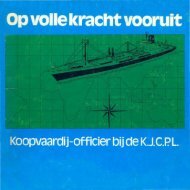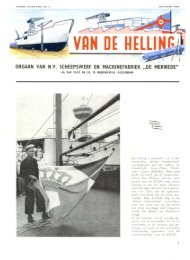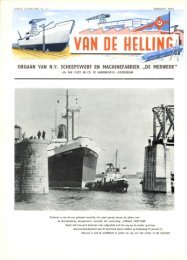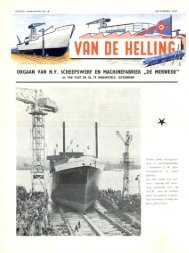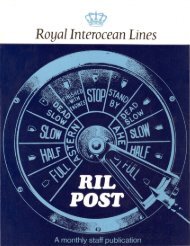Create successful ePaper yourself
Turn your PDF publications into a flip-book with our unique Google optimized e-Paper software.
Tai Ki moored at Aplichau; notice the leeboards attached t o the side of the hull.<br />
Whistling for a Weste rly Wi nd<br />
In mid June, eight men in Hong Kong<br />
were patiently waiting for a south<br />
westerly wind to set out on an epic<br />
s ix month voyage across the Pacific.<br />
Their vessel, moored at Aplichau, is<br />
a junk called Tai Ki. This is no ordinary<br />
junk. In every detail of its<br />
design it is an exact replica of a tiny<br />
clay model junk found in a tomb nea r<br />
Canton dating from the Han Dynasty<br />
206 BC-220 AD.<br />
Project Tai Ki Pacific is the culmination<br />
of several years of research on<br />
t he part of skipper, Carl Grage and<br />
other members of the Tai Ki team.<br />
(See RIL Post September 1973).<br />
The project w ill attempt to prove<br />
that the Olnec and Chevin t ribes<br />
of Central America were descended<br />
from Chinese of the Han Dynasty<br />
who t ravelled across t he Pacific in<br />
junks made of pine and camphor<br />
wood with sa il s of bamboo matting.<br />
Archeologica l evidence for this theory<br />
has been found in Central America<br />
and Mexico; pottery and sculpture<br />
unearthed display symbols and lettering<br />
remarkably similar to Chinese<br />
work of the Han period. However<br />
evidence that Chinese of the Han<br />
Dynasty ever sailed on the open<br />
ocean has proved difficult to find.<br />
130<br />
The vital clue was Carl Grage's<br />
discovery that Han sa ilors used a<br />
constellation of 28 stars, proof that<br />
they travelled far from t he coasts of<br />
China.<br />
Tai Ki was originally scheduled to<br />
leave Hong Kong on 25th M ay. With<br />
only a single rattan square sa il she<br />
ca nnot beat t he w ind and t hus it is<br />
imperative t hat she leave soon after<br />
this date in order to make maximum<br />
use of certain w inds and currents.<br />
She w ill sail north to latitude 40°<br />
or 50° where a strong wind from<br />
northeast China converges w it h<br />
w inds blowing up from the South<br />
Pacific. Carl Grage hopes to maximise<br />
the effect of these w inds with<br />
a strong current w hich runs for<br />
only a short duration each year. T he<br />
current should ca rry Tai Ki across<br />
the Pacific north of Hawaii to the<br />
California coast and t hen south to<br />
the Bay of Tehuantepec at the<br />
southernmost tip of M exico.<br />
It has taken 200 days to build the<br />
58 ft. Tai Ki as opposed to 60 or so<br />
for a modern junk. Only Chinese fi r<br />
could be used for the planking w ith<br />
bilian and teak for the frame and<br />
beams. It took four months just to<br />
locate suitable pieces of timber for<br />
The mast looks strong, but in ca<br />
spare on board.<br />
the mast and spare mast. Ch inese fir<br />
is not easy to bend and the workmen<br />
used no mechanical tools except an<br />
electric drill to bore ho les.<br />
The junk is held together by 300<br />
wooden dowels; not a single nail or<br />
screw has been used. The dowels<br />
are made from a special hardwood<br />
which comes from the lychee tree;<br />
four such trees were purchased from<br />
the New Territories to make the<br />
dowels. Many of t he dowels broke<br />
when first inserted and often several<br />
attempts were necessary before t he<br />
craftsmen achieved a secure fit.<br />
Wherever possible the dowels were<br />
left protruding so that should they<br />
work loose, it w ill be possible to<br />
split t hem and drive in a wooden<br />
wedge.<br />
The series of bamboo huts, w hich<br />
form the superstructure and living<br />
area, also posed problems and had<br />
to be reassembled many times to<br />
strike a ba lance between authenticity<br />
and seaworthiness. The wooden<br />
hull w hic h weighs 10 tons is divided<br />
into five watertight bulkheads used<br />
mainly for storage purposes. The<br />
hull has been treated w ith Tung oil<br />
to he lp preserve the wood and keep<br />
it watertight. Two leeboards are



